How to Add Travel Time to Outlook Meeting

If you often feel rushed throughout the day, adding travel time to your calendar can be a simple yet powerful solution. It’s one thing to mentally note how long it takes to drive from point A to point B — and another thing to actually block that time in your schedule.
In this quick guide, you’ll learn how to schedule travel time in your Microsoft Outlook calendar. Let’s start!

Benefits of adding travel time
Unless you’re using an AI-powered tool like Clockwise , adding travel time to a meeting does require a step or two. But here’s why it’s worth it for your time management:
- Your calendar becomes a more realistic depiction of your day or week ahead
- You can better communicate your availability to your team
- It makes it easier to plan your day and manage your schedule
- It helps you avoid the stress of rushing or running late
- It helps you prevent overbooking yourself and potentially missing out on important opportunities or events
Now that we’ve covered the benefits of scheduling travel time, let’s talk about how you can do it in Microsoft Outlook.
Enabling travel time in Outlook calendar
Travel time isn’t a native MS Outlook feature. You can try a Microsoft Teams add-in like Emma.ai , which automatically adds travel time to meetings (but with no reviews on the Microsoft app store, we can’t exactly vouch for it). Instead, we suggest scheduling travel time as its own calendar event.
Below, we’ll guide you step-by-step in creating travel time blocks. We’ll also show you a few bonus tips to keep your calendar organized as you start to include travel time in your schedule regularly.
Adding travel time to a meeting
Blocking off travel time is easy once you get the hang of it! In fact, it’s a lot like your standard meeting scheduling process. Follow the steps below to schedule travel time in the web version of Outlook.
Step 1: Open Outlook calendar
Visit Outlook.com , log in, and switch to calendar view. You can do that by clicking the calendar icon on the left sidebar menu. If you haven’t already added your meeting to the calendar, do so now.
Step 2: Create new event
Make sure your calendar is set to Week view, then create a new event by clicking into the space right before your meeting. You can also use the New event button.

Step 3: Enter details
Name the event Travel Time . Adjust the start and end times if needed. You can use a navigation app like Google Maps to estimate how much time you should block off.
(Hint: Tack on a little buffer time for parking, traffic, or a few minutes to gather your thoughts before heading into your meeting.)
Step 4: Adjust “Show As” settings
Click on More options . In the top navigation bar, click Busy , then select Away in the drop-down menu. If someone tries to request a meeting with you during that time, they’ll see your “ Away” status and know you aren’t available.
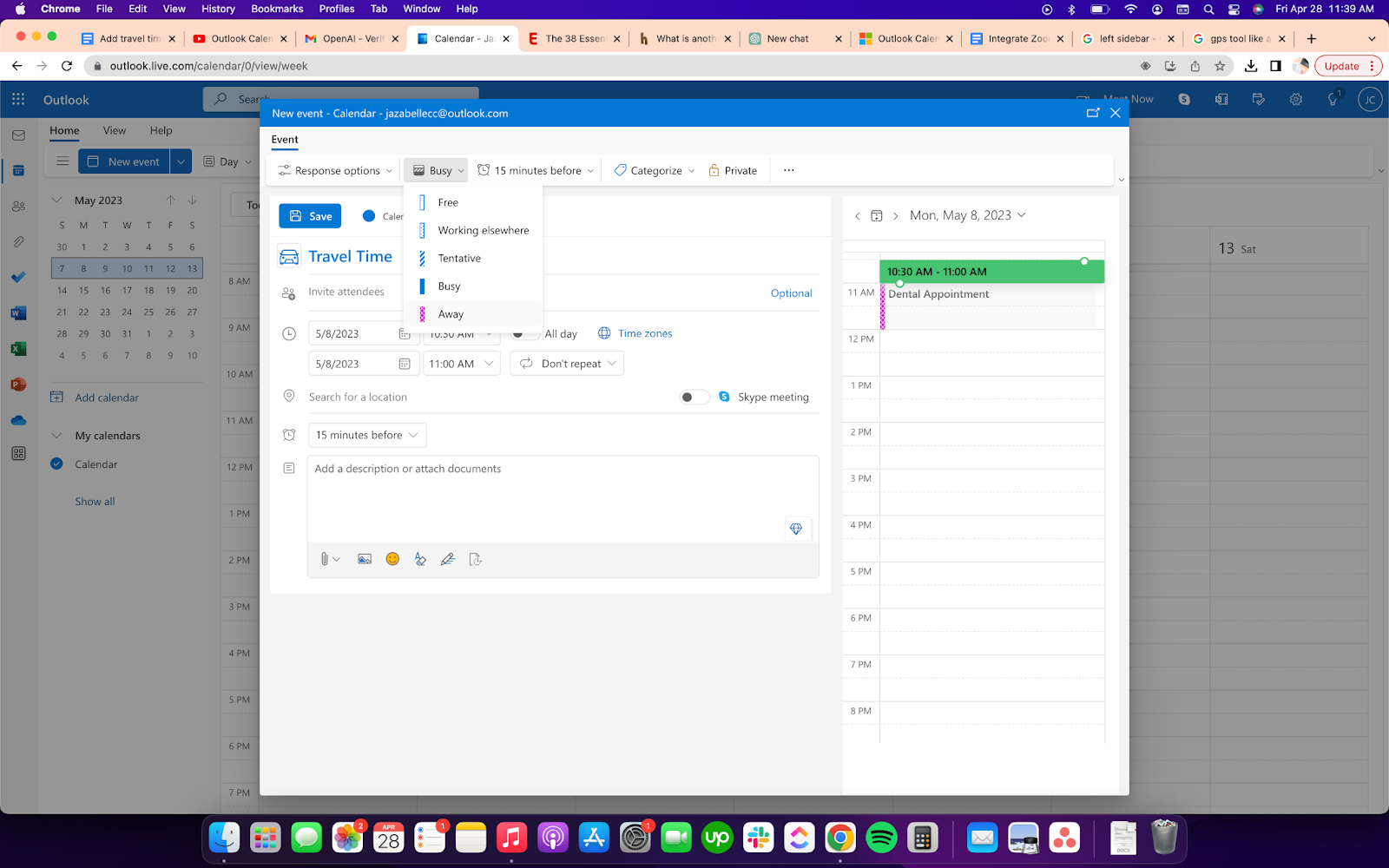
Step 5: Categorize as travel time
Click Categorize > Manage categories . In the Settings window that opens, create a new category dedicated to travel time. This assigns a color to all events categorized as travel time, helping your schedule to stay visually organized.
Exit out of the Settings window. Then, categorize the event with your new Travel Time label.
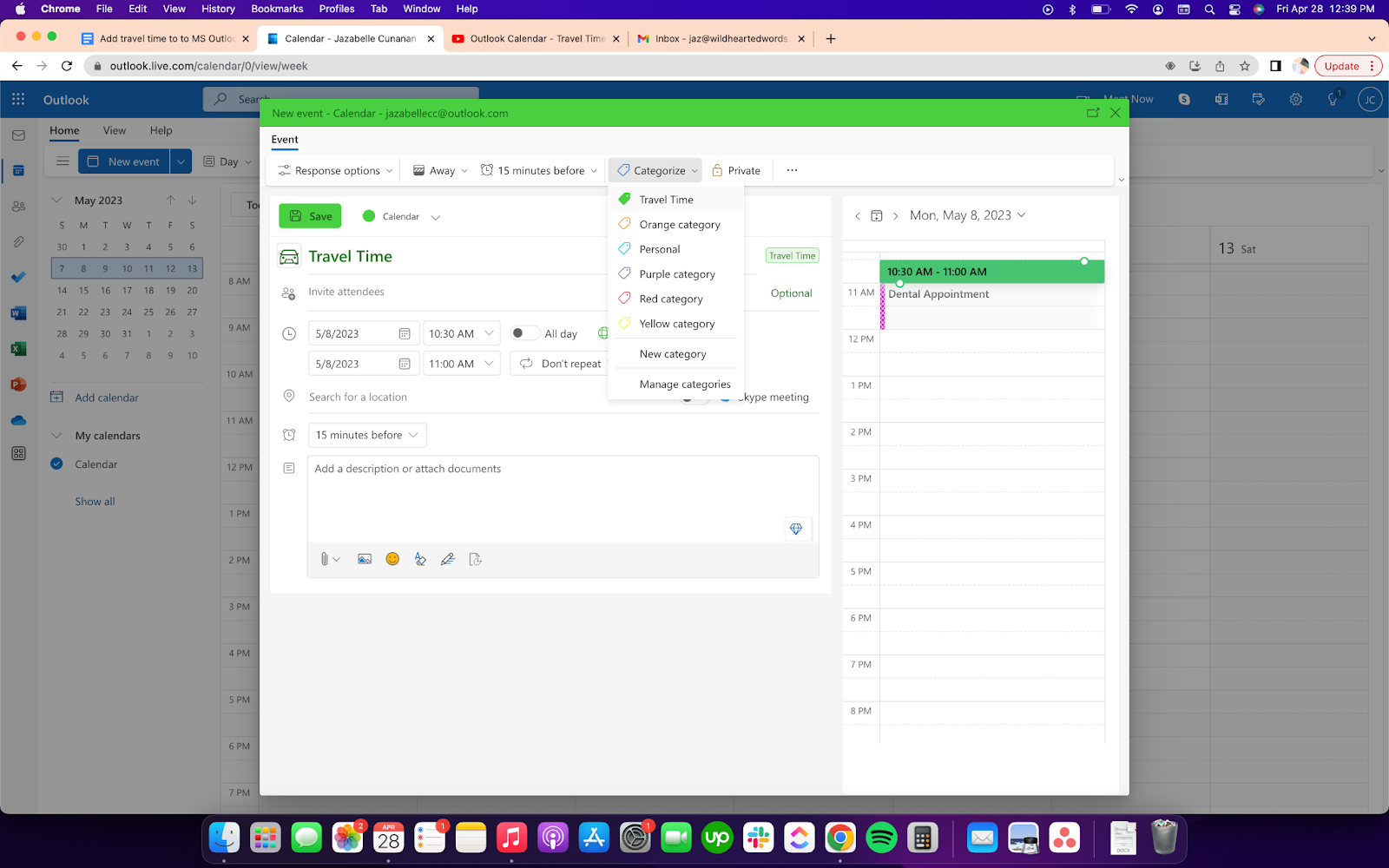
Step 6: Save your work
Click Save , and repeat this process to create a travel time block after your meeting, too. Voilà! You’ve successfully scheduled travel time. You should end up with something like this:
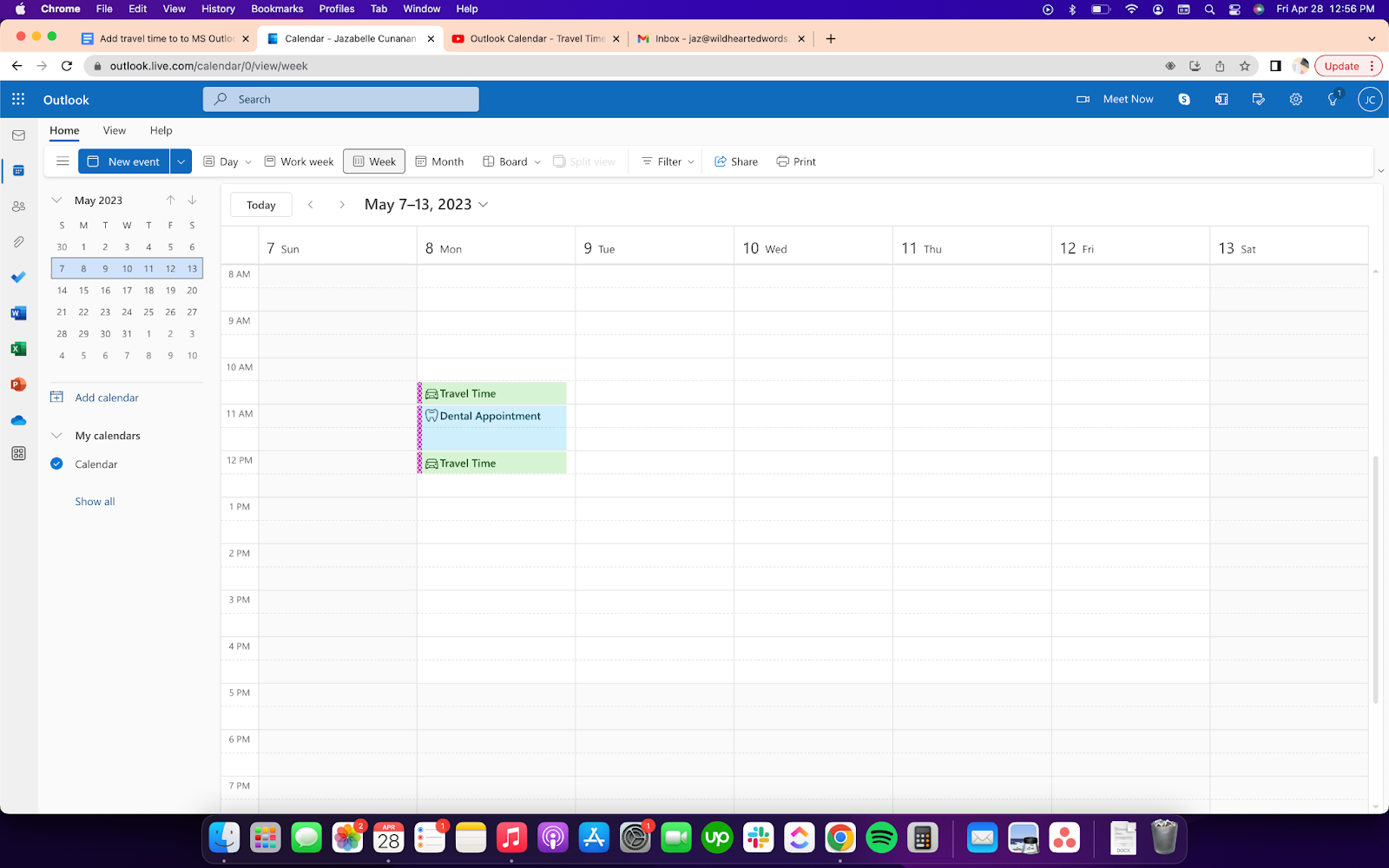
Tips and best practices to add travel time in Microsoft Outlook
- Assign a color category to travel time. Creating a “Travel Time” category allows you to color-code future travel blocks in just a few clicks. From then on, you can easily identify travel time on your schedule at a glance.
- Use calendar icons. Did you know you could add icons to your calendar events? Like color-coding, adding the car icon to travel time events makes it easier to scan your calendar and see what’s coming up. (It also makes things more fun!)
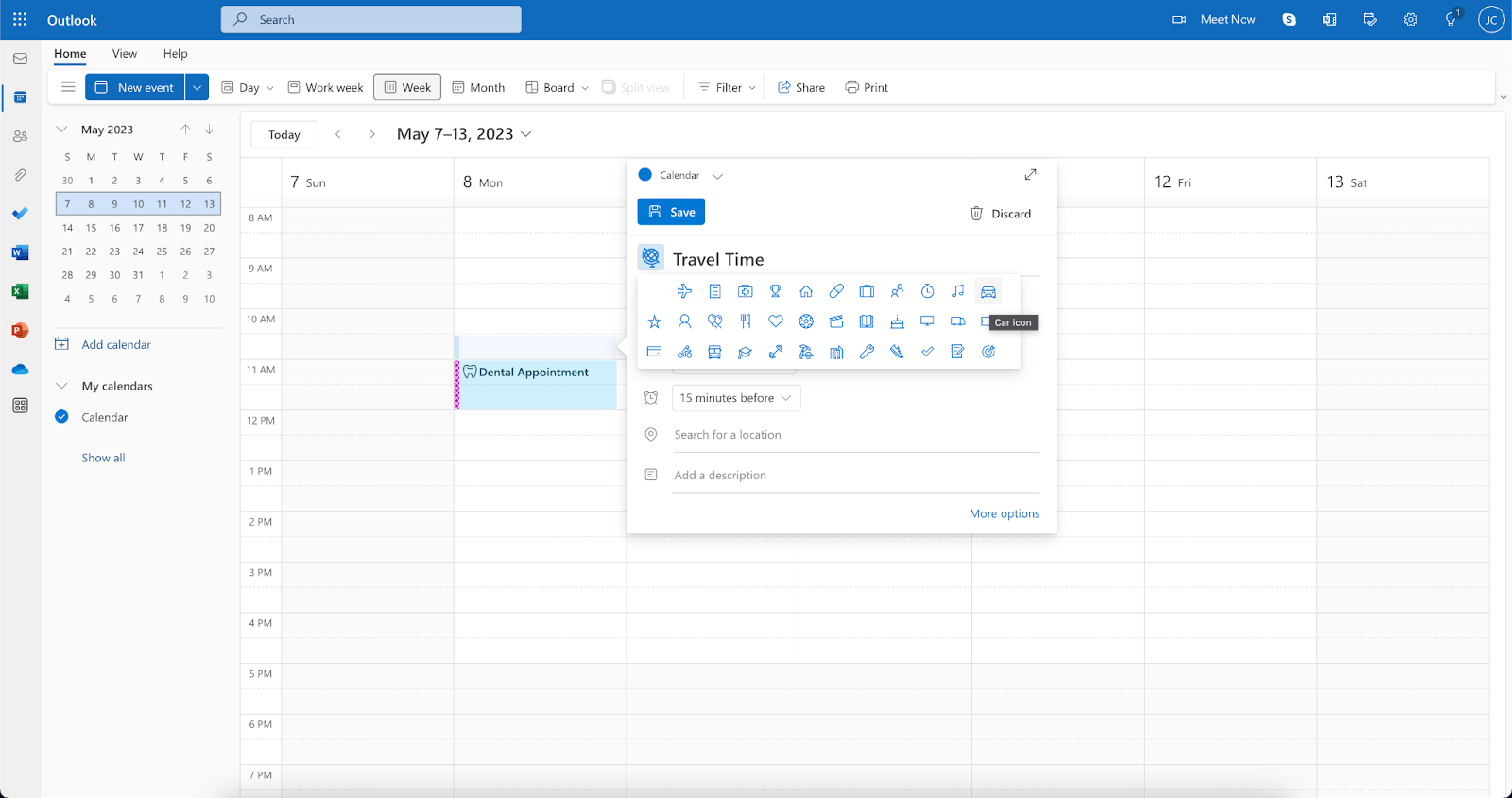
- Leverage the Show As setting. I n this setting, you can specify whether you’re free, working elsewhere, tentative, busy, or away during a particular event. This lets your colleagues know your status during any given time, without necessarily giving away all the details of your schedule. For travel time, set the Show As setting to “Away” or “Busy,” so that no one tries to schedule with you during that time.
Going forward
Unfortunately, Microsoft Outlook doesn’t offer any features designed specifically for travel optimization. To schedule travel time in your calendar, you need to add it as its own event. Not a fan of manual scheduling? Try Clockwise, which uses machine learning to identify meetings that require travel, understands how much time to block off, and automatically holds an intelligently determined amount of time on your calendar. Sign up for the Clockwise here .
About the author

Judy Tsuei is a Simon & Schuster author, speaker, and podcast host. She’s been featured in MindBodyGreen, BBC Travel, Fast Company, Hello Giggles, and more. As the founder of Wild Hearted Words, a creative marketing agency for global brands, Judy is also a mentor with the Founder Institute, the world's largest pre-seed accelerator. Judy advocates for mental and emotional health on her popular podcast, F*ck Saving Face. Follow along her journey at WildHeartedWords.com.
Subscribe to our monthly newsletter
Look out for a confirmation email in your inbox

Optimize your work day with AI powered calendar automation.
Make your schedule work for you, more from clockwise.

8 work time wasters and how to avoid them

How to schedule a meeting in Slack
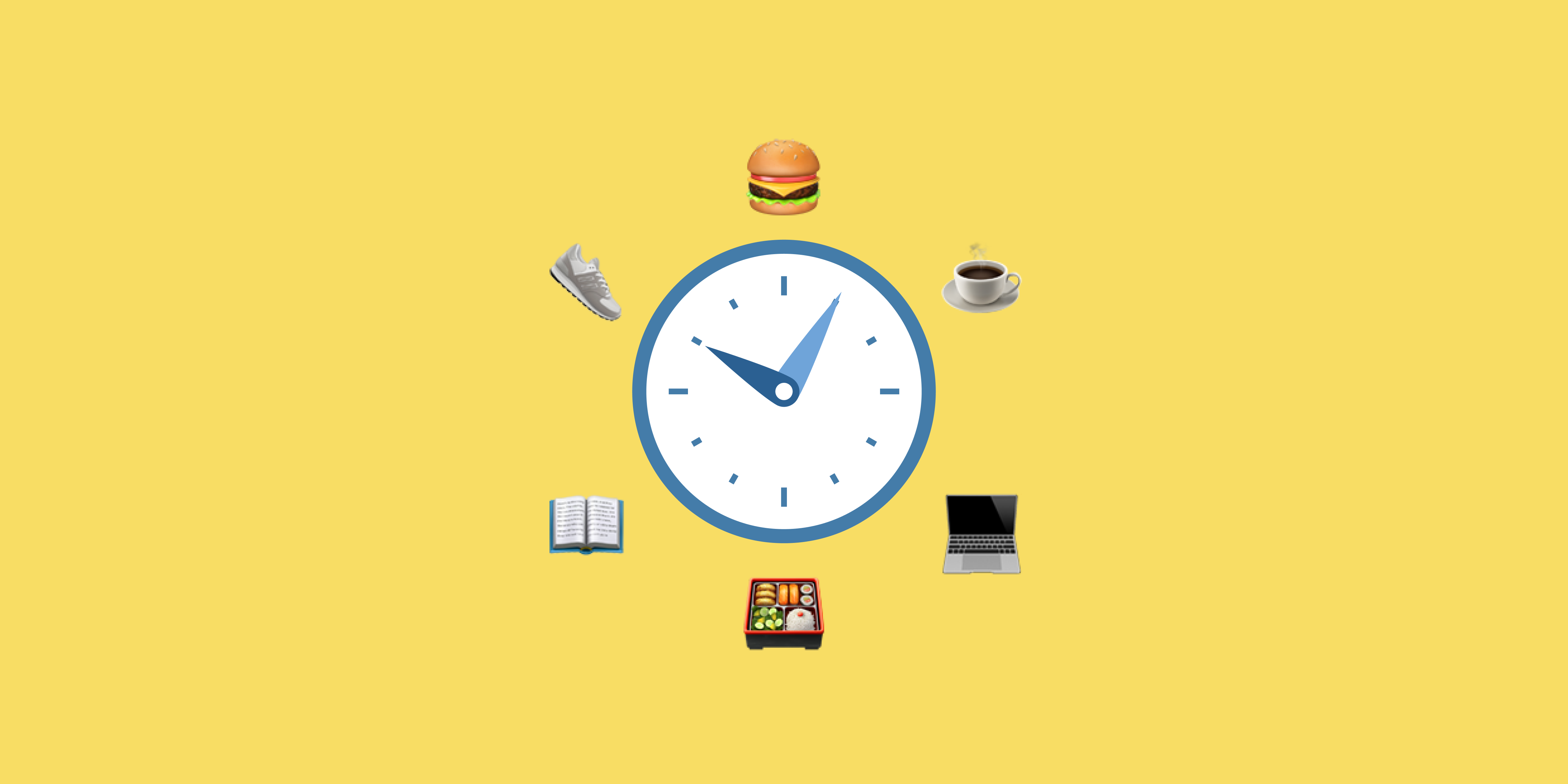
7 life-changing benefits of daily routines

Teams vs. Slack: Pros, cons, and what's best

Outlook on the Web will soon let users book travel time and transportation between meetings
Rabia Noureen
April 20, 2021

Microsoft’s Outlook e-mail service is getting some important updates in the coming months. The news comes from a recent update to the Microsoft 365 roadmap, which lists these new capabilities as in development for Outlook on the web.
First of all, Microsoft is actively working on a feature that will allow business users to book travel time appointments and transportation between meetings. “Now when you need to go to a different building or place between meetings, Outlook will enable you to book travel time and way of transportation between the places you need to go,” the company explained on the Microsoft 365 roadmap. The feature is planned for release in August this year.
The other new feature is emoji reactions, which is also coming to iOS and Android . This update will enable users to messages with love, laughter, celebration, sadness, or surprise emojis when accessing their inbox in Outlook through a web browser. Emoji reactions are expected to roll out to both mobile and web users in June 2021 .

Next up, Microsoft Outlook is adding an option to start meetings late. The feature will bring the ability for users to opt for appointments and meetings to start 0 -15 mins after the specified time. The Microsoft 365 roadmap listing suggests that the company is planning to roll out this update to the Web and Windows clients later this month.
Apart from the aforementioned features, Outlook on the web is making it easier to add OneDrive and SharePoint files to emails. Lastly, Microsoft also announced some new time management features for Outlook on the web and mobile last month, and you can learn more details in our separate post .
New Xbox Insider update brings much-needed improvements to Quick Resume
Microsoft is reportedly planning big changes for its windows 10 app store.
OnMSFT.com is built on:
Wordpress GeneratePress Azure
Theme thanks to heather.

Home About Contact Us
Join our team, © copyright 2014 - 2024 onmsft.com llc.

Robs' Blog
AI | Modern Work | Cloud | Security

Coming Soon:Outlook will be able to book you travel time between your ‘physical’ meetings
As we start to thing about post covid working it’s likely that more us will go back to have at least some physical meetings with our clients and customers and this means travel time!
Outlook will soon be getting some clever new important updates around recognising where meetings are and allowing travel time to be automatically booked.
Coming to the Outlook Web client first, this new feature will allow users to book travel time appointments and also transportation between meetings. “ Now when you need to go to a different building or place between meetings, Outlook will enable you to book travel time and way of transportation between the places you need to go ,” is the how the feature is explained in the Microsoft 365 roadmap .
Until now there have been numerous third-party add ons available that do similar things but I’ve never found these much good and they don’t work cross platform. Presumably this feature once realised will also makes its way to desktop and mobile too.
I would expect this to enter public preview as part of the #OfficeInsider programme in the next month or so.
What do you think of this addition? .Maybe it’s because people have forgotten how tenuous travel between meetings used to be now that most of our meetings are all online!
Sharing is caring:
Leave a reply cancel reply.

- Microsoft 365
- Personal and family
Stay on top of your travel and deliveries with Outlook
- The Microsoft 365 Marketing Team
Places to go, people to see. Pack your bags.
Travel can be stressful, even when you’re planning to go somewhere for fun. Staying on top of travel plans and package deliveries can become time-consuming and a hassle.
First, Outlook began automatically adding events from your email to your calendar. Now, we have more new experiences to help you stay on top of your travel plans and package deliveries, including the ability to:
- Verify your travel reservations and package delivery details with ease using simplified summary cards in your inbox and calendar.
- Check in for flights, change hotel and rental car reservations or track packages at the touch of a button.
- Stay on top of your flights with reliable reminders.
These features are rolling out to Outlook for Mac and Outlook on the web today and will soon be coming to Windows, iOS and Android, as well as the Windows 10 Mail and Calendar apps.
Smarter email, simpler reservations
Travel itinerary emails are complicated to read because they contain so much more than just your reservation. It especially gets complicated when the itinerary includes multiple flights, hotel reservations and rental car confirmations. Outlook now displays the most important information from travel itineraries and puts them in an easily readable summary on top of your email.
Quick actions at your fingertips (or a click of your mouse)
In addition to helping you see your travel plans at a glance, the summary cards provide you with quick actions for the key things you need to do. No more hunting for the check-in link in a long confirmation email or trying to find where to change your hotel reservation. It’s now just a tap or click away in the summary card above the email to go directly to the provider’s specific web page for the action.
All your travel info, automatically added to your calendar
In addition to smarter email experiences, Outlook automatically adds travel events to your calendar with the same summary cards for each step of your trip detected in the reservations. The events include everything you need to know, such as date, time, locations, confirmation number and a few other key pieces of info you might need at your fingertips. You can go to the original booking email with a single click from the calendar event in case you need to look up more details.
Travel updates and cancellations happen—for good or not so good reasons. Either way, Outlook automatically keeps the events on your calendar updated with new information from your travel provider.
Helpful check-in reminders to keep you on time
Timing is everything and it can mean the difference between getting the seat you want or settling for one you really don’t want. Not all airlines are great at notifying and reminding you when it’s time to check in for your flight. Outlook will always send you a reminder email exactly 24 hours in advance with a link to the airline’s check-in experience. What’s more, you can set an Uber ride reminder so you always get to airport on time.
And three hours before your flight takes off, we’ll remind you again, so you can plan to be at the airport on time.
And never miss package deliveries!
We know travel is not the only thing you need to keep track of, so we are also adding package tracking experiences. When you receive a shipping confirmation email, we’ll summarize the most important info in a card above the email and automatically add an event to your calendar (for non-commercial accounts) to provide quick actions.
Frequently asked questions
Q. When will these features be available?
A. We’ve started the roll out in North America and will be expanding globally next. Some Outlook on the web and Outlook for Mac users will see these features today. If you don’t, you can expect to see them soon.
Q. Which users have access to these features?
A. These experiences will be available for users with Office 365 subscriptions that include Exchange Online and those users with new or upgraded Outlook.com accounts.
Q. What do I need to do to start using these features?
A. There is nothing you need to do. The features will automatically start working in your Office 365 account or your new Outlook.com account when you receive a travel reservation or package delivery email from a supported provider.
Q. What settings are available for the automatic calendaring feature?
A. In Outlook on the web, click the Settings (gear) icon, Options and then Calendar . The settings are in “Events from Email.” Changing the setting on the web will change all Outlook clients. Travel events are on by default for all account types. Package delivery events are on by default for Outlook.com accounts, but not for commercial accounts.
Q. If I share my calendar with someone, will they see my flight information?
A. Only if you want them to. The events are marked private by default, so the details will not be visible to someone with whom you shared your calendar. You can change the default in the Settings mentioned above.
- Schedule events Article
- Share calendars Article
- Customize your calendar Article
- Manage your contacts Article
- Microsoft To Do Article

Customize your calendar
Customize your calendar in outlook on the web.
Change the view
In your calendar, choose from the following views:
Choosing Split view lets you see the calendars you have selected side-by-side.
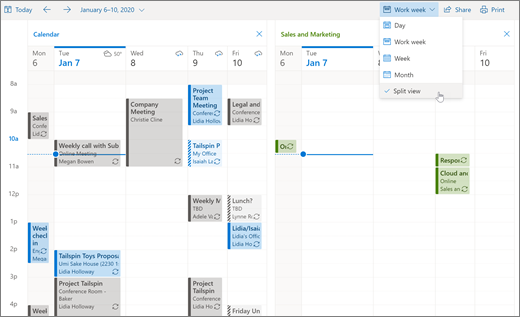
Get back to today
Anytime you're browsing your calendar, save yourself time and select Today to go straight back to the current day.
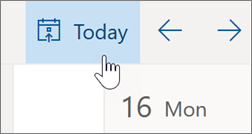
Change your calendar settings
Select Settings > View all Outlook settings > Calendar .
Choose one of the options to change each setting:
View - Personalize your calendar's appearance.
Events and invitations - Control defaults when events are created and how meeting invitations, responses, and notifications are handled.
Weather - Customize your weather experience.
Events from email - Control how events are added from email to your calendar.
Shared calendars - Share a calendar with specific people, publish a calendar for anyone with a link to see, and manage shared calendars.
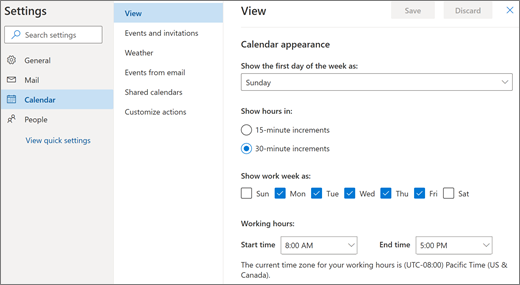
Note: Features and information in this guide apply to Outlook on the web as available through Microsoft 365.

Need more help?
Want more options.
Explore subscription benefits, browse training courses, learn how to secure your device, and more.

Microsoft 365 subscription benefits

Microsoft 365 training

Microsoft security

Accessibility center
Communities help you ask and answer questions, give feedback, and hear from experts with rich knowledge.

Ask the Microsoft Community

Microsoft Tech Community

Windows Insiders
Microsoft 365 Insiders
Was this information helpful?
Thank you for your feedback.
Search for: Search Button
Travel time add-in for Outlook
Instyler’s Travel add-in for Outlook lets you block the travel time around an appointment in Outlook calendar.
One long-standing problem with Outlook is the lack of a ‘travel time’ option. You can make an appointment but there’s no direct way to include the time it takes to get to and from the location.
Instyler’s Travel add-in for Outlook lets you block the travel time around an appointment in Outlook calendar. The travel add-in that supports Outlook 2003, 2007 and 2010. Using this add-in you can not only keep tab on travel time for out-of-office appointments but also prepare expense reports for these travels. Install Travel Add-in
Download the trial version visit the Instyler website http://www.instyler.de/ and download the zip file containing necessary exe file to install the trial version. Choose download based on the Outlook version you have.
“Travel Add-in for Outlook” installation will install any necessary components as well.
After the installation, open Outlook. You will see the installed Travel add-in loading. You’ll be prompted to confirm the installed add-in.
Click on “Install” button in “Microsoft Office Customization Installer” window.
You will get a message about successful installation of the add-in. Start using the add-in by entering the address of the start location or you can simply click on “Start using the Travel Add-in” button and later enter the address. You can click on “More options” button to customize the add-in options. We will discuss more about this later. Using Travel Add-in
The Travel add-in will be integrated in the Outlook calendar. You can open a new appointment or existing appointment to find the Travel add-in menu.
In the Travel menu you can enter the travel time to reach the destination.. The range of minutes is defined in the “Options”. You can also choose the mode of transportation like Car, Train, Bicycle or Walking. Likewise you can choose the time that would take to return back and also the mode of transportation. If you are aware of the distance between the two locations you can enter that in miles/kilometers (choose in the Options dialog).
You can make use of “Use estimated” feature which automatically calculates the estimated travel time between the start and end locations for different modes of transportation, provided you enter the location from where you start and the destination address .
Once you create a new appointment with the travel details added, the Travel add-in will enter this information in the calendar to represent the travel and return times you chose in the appointment. The selected modes of transportation for the travel and travelling location are also entered. Travel and return information is always placed before and after the appointment automatically.
Expense Report
Using the Travel add-in you can easily create expense reports to keep track of the official travel details and its corresponding costs. To create expense report you can either click on the “Expense report” link under Calendar | Home | Travel Add-in | Expense report or click on “Create expense report” link in an existing appointment.
When you click this link, “Create expense report” window pops open where appointments list based on the date range selected is displayed.
You can select required appointments for which you want the expense report to be created and click on “Create report” button.
A excel file containing all the information pertaining to the appointment will be generated. This excel file is editable and can be customized to accommodate more fields and additional data. It can also be used as a template for future use. Options
Travel add-in has a commendable range of configuration options.
To customize some of the options in Travel menu, open a new or existing appointment and click on Appointment | Travel | Options.
In the Travel Add-in options window that pops open you can edit the add-in values like start address, add durations for travel and return time, add items to the list of available transportation types, mention subject text and template file used for expense reports, etc.
Travel Add-in
The free trial is fully functional for 30 days, download from here . After that the price is on a per user basis. Single user $24.95 , 2-4 users it costs $21.95 each, 5-9 users $19.95 each, 10-49 users $18.95 each and 50+ users $17.95 each.
Travel add-in works for Outlook 2010 (32 and 64 bit), Outlook 2007 and Outlook 2003 though some, unspecified, features are not available in the Outlook 2003 version. The add-in is available in English, German and Dutch languages for the user interface. Support is available through the web site.
- Outlook 2010 – calendar preview of appointments
- Easy invitations in Outlook
- Adding a time zone to Outlook
- Sharing Outlook appointments – the right way
- Adding an appointment from a web site
- Outlook Calendar tips
- Outlook and your warranties
- An Outlook on Categories
- Sharing an Outlook Appointment
- Google Calendar works with Outlook appointments
About this author
Office Watch
Office 2021 - all you need to know . Facts & prices for the new Microsoft Office. Do you need it? Office LTSC is the enterprise licence version of Office 2021.
Office 2024 what's known so far plus educated guesses. Microsoft Office upcoming support end date checklist.
Latest from Office Watch
- Translate automatic or manual in Outlook
- Microsoft Mesh makes “magical” online meetings
- Why are Teams and Office divorcing?
- Pivotby – Excel’s new faster PivotTables
- More Excel on the web improvements
- All about editing an incoming Outlook message
- What “Update License” means on Microsoft 365 menus
- Excel’s warning about dates and centuries
- Write Excel formulas fast with free Copilot
- Easter images and icons in Microsoft Office
- Credit Card 💳 symbol in Word, Excel, PowerPoint and Outlook
- Yes, there will be a new version of Microsoft Office
- All about Office 2024 for Windows and Mac (so far)
- In person vs virtual event option coming to Outlook
- Checklists now in Microsoft Word
- Start Grouping in Excel for better looking sheets
- Three more Word features reach the web version
- Web link previews in Word for web
- Turn Excel into an AI / LLM wonder
- Don’t trust any text message
Automatically block off time before and after meetings
Slipstick Systems
Last reviewed on March 6, 2020 53 Comments
Applies to: Outlook 2019 (Win), Outlook 2016 (Win), Outlook 2013, Outlook 2010
I use these macros not for travel time, but to add prep and follow up time to meetings (and also in case we need a little more time to finish up) but they serve the same purpose: to block off time on the calendar so no one can invite you to a meeting too close to another meeting.
The first macro is automatic. It watches the calendar folder and when a new meeting is added, it creates busy appointments before and after the meeting to block the time off for meeting prep or travel time. This macro works only with meetings, not appointments.
If you prefer to add the time manually, the second macro on the page blocks off time before and after the selected appointment or meeting.
These macros use a set time for the added appointments, in this case 30 minutes, but you could just as easily use an input box to enter the time specific to a meeting or a userform to select from a list of times.
September 13 2018: Edited macro so it will create travel time appointments for both meetings you create and those you are invited to. Note that it will create the events when the meeting invitation arrives and is added to the calendar as Tentative. It will not remove the events if you decline the meeting.
' Add to ThisOutlookSession Option Explicit Private WithEvents CalendarItems As Items Dim myCalendar As Outlook.Folder Private Sub Application_Startup() Dim objNS As NameSpace Set objNS = Application.Session Set myCalendar = objNS.GetDefaultFolder(olFolderCalendar) Set CalendarItems = myCalendar.Items Set objNS = Nothing End Sub Private Sub CalendarItems_ItemAdd(ByVal Item As Object) Dim TimeSpan As Long 'how much time do you want to block (in minutes) TimeSpan = 30 'If Item.MeetingStatus = olMeeting Then If Item.MeetingStatus = olMeeting Or Item.MeetingStatus = olMeetingReceived Then On Error Resume Next Dim oAppt As AppointmentItem Set oAppt = Application.CreateItem(olAppointmentItem) With oAppt .Subject = "Meeting Prep Time " & Item.Subject '30 minutes before .StartUTC = Item.StartUTC - TimeSpan / 1440 .Duration = TimeSpan .BusyStatus = olBusy .ReminderSet = False .Save End With Set oAppt = Application.CreateItem(olAppointmentItem) With oAppt .Subject = "Meeting Review Time " & Item.Subject .Start = Item.End ' use number for duration if you are using a different length here .Duration = TimeSpan .BusyStatus = olBusy .ReminderSet = False .Save End With End If End Sub
Manually add travel time
Add this macro the a new module and create a button for it on the Quick Access Toolbar. To use, select an appointment and click the button.
Sub BlockOffTime() Dim objApp As Outlook.Application Set objApp = Application ' On Error Resume Next Dim oAppt As AppointmentItem Dim cAppt As AppointmentItem Set cAppt = objApp.ActiveExplorer.Selection.Item(1) Set oAppt = Application.CreateItem(olAppointmentItem) ' MsgBox cAppt.StartUTC With oAppt .Subject = "Meeting Prep Time" '30 minutes before .StartUTC = cAppt.StartUTC - 0.020833 .Duration = 30 .BusyStatus = olBusy .ReminderSet = False .Save End With Set oAppt = Application.CreateItem(olAppointmentItem) With oAppt .Subject = "Meeting Review Time" .Start = cAppt.End .Duration = 30 .BusyStatus = olBusy .ReminderSet = False .Save End With Set cAppt = Nothing End Sub
Remove Past 'Time Block' Appointments
While it is fairly easy to use Instant Search or a list view to remove these meeting from your calendar, a simple macro can remove all previous meetings added to block off time.
Sub DeletePasteBlockTime() Dim objOutlook As Outlook.Application Dim objNamespace As Outlook.NameSpace Dim objSourceFolder As Outlook.MAPIFolder Dim objDestFolder As Outlook.MAPIFolder Dim objVariant As Variant Dim lngMovedItems As Long Dim intCount As Integer Set objOutlook = Application Set objNamespace = objOutlook.GetNamespace("MAPI") Set objSourceFolder = objNamespace.GetDefaultFolder(olFolderCalendar) For intCount = objSourceFolder.Items.Count To 1 Step -1 Set objVariant = objSourceFolder.Items.Item(intCount) DoEvents If objVariant.Subject = "Meeting Prep Time" Or objVariant.Subject = "Meeting Review Time" Then If objVariant.Start < Now Then objVariant.Delete 'count the # of items moved lngMovedItems = lngMovedItems + 1 End If End If Next ' Display the number of items that were moved. MsgBox "Moved " & lngMovedItems & " messages(s)." Set objDestFolder = Nothing End Sub
How to use the Macro
First: You will need macro security set to low during testing.
To check your macro security in Outlook 2010 or 2013, go to File, Options, Trust Center and open Trust Center Settings , and change the Macro Settings . In Outlook 2007 and older, it’s at Tools, Macro Security . If Outlook tells you it needs to be restarted, close and reopen Outlook. Note: after you test the macro and see that it works, you can either leave macro security set to low or sign the macro .
Now open the VBA Editor by pressing Alt+F11 on your keyboard.
To use the macro code in ThisOutlookSession :
- Expand Project1 and double click on ThisOutlookSession .
- Copy then paste the macro into ThisOutlookSession . (Click within the code, Select All using Ctrl+A, Ctrl+C to copy, Ctrl+V to paste.)
Application_Startup macros run when Outlook starts. If you are using an Application_Startup macro you can test the macro without restarting Outlook by clicking in the first line of the Application_Startup macro then clicking the Run button on the toolbar or pressing F8.
To put the code in a module:
- Right click on Project1 and choose Insert > Module
- Copy and paste the macro into the new module.
More information as well as screenshots are at How to use the VBA Editor .
About Diane Poremsky
A Microsoft Outlook Most Valuable Professional (MVP) since 1999, Diane is the author of several books, including Outlook 2013 Absolute Beginners Book. She also created video training CDs and online training classes for Microsoft Outlook. You can find her helping people online in Outlook Forums as well as in the Microsoft Answers and TechNet forums.
Hi Diane - thank you so much for this, it's incredibly useful and I appreciate you sharing the script. I have a quick query if you have time to consider it.
I'm using the first/auto version, and I find that when I receive a meeting I'm getting duplicate time blocks - so the time blocks go in when the invite is first received (and the meeting is in my diary as tentative), but then when I respond/accept the meeting, I get another two time blocks added. So I end up with four in total (two before and two after).
Am I doing something incorrect with the script?
Thanks in advance for your help.
I'll test it (and update) - but I'm guessing it is this line - that is causing it to do it both when it arrives and when you reply. Or when it syncs back after accepting it. The best thing might be to check the status and only create if accepted. If Item.MeetingStatus = olMeeting Or Item.MeetingStatus = olMeetingReceived Then
Thanks you for your response Diane. Does this mean changing the Item.MeetingStatus = olMeetingReceived to Item.MeetingResponse = olMeetingAccepted?
I haven't had a chance to test it yet, but either that or check to see if accepted, then create the appointments.
My company don't allow to change the Marco security level, is there another option, like power automat, to achive this?
Power automate might do it - I will look into it.
I want to create an appointment (manually) that is for the first available 30-min slot starting 5 days before an appointment - is this possible? I've spent about an hour googling your site and also actual google :) and I've not come up with anything I can use. I'm good at modifying existing code but I can't write my own, so if someone could point me to something similar in VBA that would also help!
Thank you, this is much better than "shorten meeting" option in Outlook. In real life, you need buffer times both before and after meetings. It can be due to preparation, travel, etc.
Good morning,
Diane, can you send the most updated code for Automatically block off time before and after meetings Duane
This is only version I have. Is it not working for you?
Hello Diane,
absolutely helpful script! It's my first touch to VBA scripts but I love it from the beginning. :-) I splitted the TimeSpan to TimeSpanBefore and TimeSpanAfter because I want to have different slots here. Works nice. The calendar does not look nie because my time span is just 5 and 10 minutes so all looks scrambled. But this is how Outlook displays eveything and has nothing to do with your script for sure.
The only thing which does not work is the cleanup of old entries. I made a meeting in the past and it was created with surrounding buffer. But starting the cleanup results in "moved 0 message(s)" and I don't see why. Is there anything special I have to take care for?
Regards Marco
Hi Diane, thank you so much.
My calendar now fully looks blue and it's hard to read what are actual meetings vs what is review/ prep time.
Is it possible to add color coding/ categorisation into this which makes it easier to glance meetings/ appointments?
You can add .categories = "category name" to add a category to the appointments.
With oAppt .Subject = "Meeting Prep Time" .categories = "category name"
With oAppt .Subject = "Meeting Prep Time" '30 minutes before .StartUTC = Item.StartUTC - TimeSpan / 1440 .Duration = TimeSpan .BusyStatus = olBusy .ReminderSet = False .Categories = "Gap" .Save End With Set oAppt = Application.CreateItem(olAppointmentItem) With oAppt .Subject = "Meeting Review Time" .Start = Item.End ' use number for duration if you are using a different length here .Duration = TimeSpan .BusyStatus = olBusy .ReminderSet = False .Categories = "Gap" .Save
Can you use this for a calendar you have edit privileges on and not your default calendar? If so how
Yes, you just need to pull in the correct calendar. https://www.slipstick.com/developer/working-vba-nondefault-outlook-folders/
Sending and Retrieval Tools
Mass Mail Tools
Compose Tools
Duplicate Remover Tools
Mail Tools for Outlook
Online Services
Calendar Tools
Schedule Management
Calendar Printing Tools
Calendar Reminder Tools
Calendar Dates & Data
Time and Billing Tools
Meeting Productivity Tools
Productivity
Productivity Tools
Automatic Message Processing Tools
Special Function Automatic Processing Tools
Housekeeping and Message Management
Project and Business Management Tools
Choosing the Folder to Save a Sent Message In
Run Rules on messages after reading
Help & Suggestions
Submit Outlook Feature Requests
Slipstick Support Services
Buy Microsoft 365 Office Software and Services
Visit Slipstick Forums.
What's New at Slipstick.com
Home | Outlook User | Exchange Administrator | Office 365 | Outlook.com | Outlook Developer Outlook for Mac | Common Problems | Utilities & Addins | Tutorials Outlook & iCloud Issues | Outlook Apps EMO Archives | About Slipstick | Slipstick Forums Submit New or Updated Outlook and Exchange Server Utilities Send comments using our Feedback page Copyright © 2024 Slipstick Systems. All rights reserved. Slipstick Systems is not affiliated with Microsoft Corporation.
Sign up for Exchange Messaging Outlook
Our weekly Outlook & Exchange newsletter (bi-weekly during the summer)
Please note: If you subscribed to Exchange Messaging Outlook before August 2019, please re-subscribe.
Never see this message again.
Barret Codes
Hello. It's just me
Automatically Adding Travel Time To Your Calendar

Even in this world of video meetings on Teams, Zoom, or wherever, there are still occasions when you need to travel to an onsite meeting somewhere. In these cases, it can be useful to automatically block out travel time before and after to ensure that your calendar reflects when you’re not going to be in the office. Power Automate makes it easy to add some travel time to your calendar.
Note: As with most of the more useful connectors, some of the connectors mentioned here will require a paid Power Automate account.
This flow makes use of the following connectors:
- Outlook.com
The first thing you’re going to need is a developer account for Bing Maps. Don’t worry. It’s easy to sign up and for limited use, it’s free. Head over to the Bing Maps Developer Portal and create an account. Once you have created your account, open the “My keys” menu under the “My account” header. Click to create a new key and select a key type of “Basic” and an application type of “Dev/Test”. This is the free account tier and will provide plenty of access for the purpose of this flow.

Once you have created the key, copy it down. We’ll need it for our Power Automate connector.
Flow Trigger
Now we can go ahead and start creating our flow in Power Automate. You’ll want to trigger the flow whenever an event gets added to your calendar. In our case, we’re going to use Outlook.com’s “When a new event is created (V2)” trigger.

Select the calendar ID of the calendar you want to have to trigger the flow. The default is just called “Calendar” for most Outlook types. We don’t need to detail any of the other parameters.
The next thing I’m going to add is a variable to use to calculate the amount of travel time to block. You don’t strictly need the variable. I’m just breaking it out into multiple steps to demonstrate various pieces of logic. This will be an integer variable and I’ll call it timeDiff.
The next step I’m going to add is a Condition action. We only want to try and add travel time if the meeting invite includes an address in the location field of the event. The exact conditions will vary depending on your needs, but the following conditions are a good starting point.
- Location text length > 0
- Location does not contain the word Zoom
- Location does not contain the word Teams
- Location does not contain the word Webex
We can check the length of the location field with the following expression:
The final result will look something like this:

Bing – Get Route
Under our “If yes” branch, we’re going to add a few more steps to calculate our travel time and then add it to our calendar. Add an action in the box and search for the Bing Maps “Get route” action. When you select this action you’ll be asked to create a new connector if you don’t already have one. In this connector, you’ll need to give it a name and add the API key that you created in the Bing Maps Developer Portal.
For this action, you will pass in a number of parameters such as your start and end addresses. The result that comes back will be a description of your journey in JSON data format. It will include quite a few details, like step-by-step driving directions. But we only care about the travel time value (called Travel Duration) for this demo. This value gets returned as seconds. For example, for a test I ran, driving from my office to the Columbus airport returned 1847 seconds.
For Waypoint 1 you’ll enter your starting location. Put in the address of wherever you usually work from. You can get fancy and come up with ways of calculating where you might be starting from, but we’re keeping it simple for now. For this demo I put in the office location I work from when I’m in the office.
For Waypoint 2 we’re going to pull the location value from the trigger event. When this step runs, the value of location will be passed into Bing as your destination. If Bing Maps can’t figure out what the destination actually is based on that value, it will throw an error and your flow will fail. You can either add some appropriate error tracking or just leave it like this because in this case, if we can’t get a route from Waypoint 1 to Waypoint 2 then we don’t want to add anything to our calendar.
For Travel mode we’ll want to set “Driving”.
You can change the other default values as appropriate for your driving habits. For this demo, I changed Optimize to timeWithTraffic (which will account for typical traffic patterns). Unfortunately, the “Get route” action doesn’t let you pass in the date and time of when you will be traveling, so the traffic delays will be calculated based on the time that you make the request. But, it’s better than nothing.
The other default I changed is the Distance unit. It defaults to kilometer, but being in the US myself I changed it to Mile. It really doesn’t make a difference for this demo, but if you wanted to get a little fancier and include something like the distance you will drive in the travel time calendar block, then it will be needed.

Add Travel Time To My Calendar
The last few steps will calculate how much travel time to add and add that as an event on my calendar that will appear immediately prior to the trigger event. First, we’re going to calculate how many minutes our travel time will include. We’re going to calculate this as a negative number of minutes (I’ll explain why in a moment). We’re also going to add a buffer of 15 minutes to allow time to walk to my car from my office, time to walk from the car to the meeting location at the destination, and a couple of extra minutes to allow for traffic variations. This isn’t a perfect system, but it’s a good place to start.
Add a “Set variable” action and we’ll set the value of our timeDiff variable to the following expression:
This takes the travelDurationTraffic value, divides it by 60 to convert seconds into minutes, then includes our extra 15 minutes of buffer. This gives us a negative value of minutes. In my example above of traveling to the airport, I get a value of 46 minutes.
Now we need to convert this number of minutes into a dateTime value. Here’s why we got our value as a negative number. Power Automate has an “addMinutes” function, but not a subtract minutes function. So we’ll take the start time of the original trigger event and then add that number of negative minutes to get the starting time of our Travel Time event. The following expression gets us what we want:
Add a Compose action to the flow and set the Inputs to that expression. This will give us a dateTime value. Now, all we need to do is add a new event to our calendar to block off that travel time.
Add an Outlook.com “Create event (V3)” action to our flow. Select the Calendar id of the calendar to add your event. As before the default Outlook calendar id is “Calendar”. Give your event a subject. I just used the value “TRAVEL TIME” so it stands out a bit.
For the Start time of the event, use the output from our previous Compose action. And for End time we’ll use the starting time of our trigger event.
None of the other fields are required, but you could add things if you wanted. For example, you might include the distance calculated. You might also include the returned step-by-step travel directions in case your GPS fails to work the day of. Who knows what you might come up with?
That’s all you need to add some travel time to your calendar. You can enhance this with some other ideas.
- Add another step to travel back to the office
- If the start time is the beginning of the day, start from home instead of the office
- If the event is all day, skip travel time entirely
There are all kinds of things you might add depending on your circumstances, but this is more than enough to get you started. A good way to get help get your calendar better organized.

Husband, father, gamer, developer, manager, writer, creative, blogger, model railroader, Buckeyes fan
Related Posts

- Development
C# Advent 2021 – Using C# Code in Power Automate
- December 13, 2021
Power Automate has a fantastic feature in preview that lets you add some C# code to your flows. It requires using a custom connector, so it’s limited to those with a license that allows that. There are also a number of other limitations which I’ll get into later. But it’s a start.
How do I get started with Power Automate?
- February 6, 2024
When I speak at conferences or user groups about Power Automate, one of the questions I get asked the most (aside from how to understand the confusing licensing), is how to get started with Power Automate, or the Power Platform in general. I thought I would write a post on […]

Creating a Custom Connector – Part I
- November 17, 2021
For those with the higher tier licenses, along with being able to use the premium connectors, you also have the ability to create your own custom connectors that you can use to connect to just about any API on the web.
Leave a Reply Cancel reply
You must be logged in to post a comment.

- Productivity Center
How to Use Your Calendar for Travel

Thursday, August 10th, 2023

There are many benefits to traveling , such as:
- Travel may reduce heart disease risk, according to research .
- One of the most significant benefits of traveling is stress relief. Even a short vacation can help reduce stress, according to a study of 40 German middle managers published in July 2018 in the International Journal of Environmental Research and Public Health .
- Regular travelers (defined as trips at least 75 miles from home) report being 7 percent happier than those who travel rarely or not at all, according to research on a Taiwanese population published in January 2021 in the journal Tourism Analysis .
- It may be helpful for you to travel if you’re feeling burned out. Social scientist Adam Galinsky has found that travel and creativity go hand-in-hand, according to his study at Columbia University .
- Traveling can naturally encourage more movement and physical activity if you spend most of the day at a desk.
The downside, however, is that traveling can be stressful and involve much work. Everything from flights to accommodations to activities and sightseeing needs to be planned. You can quickly become overwhelmed if you don’t have a sound system for keeping track of everything.
It’s here that your calendar comes in handy. How? When planning a trip, an organized calendar can save the day. You won’t forget anything, since you can keep track of everything in one place.
Let me show you how to use your calendar for travel in this blog post. You’ll learn how to create a travel calendar, add events, and keep an organized calendar.
Creating a Travel Calendar
Step 1: pick a calendar tool that works for you..
A travel calendar can be created with various tools. The most popular options are a physical planner, spreadsheet, or travel planning app .
- When choosing a physical planner, ensure it has enough space for all your travel details. Additionally, you’ll need to decide whether you want a daily planner or a weekly planner.
- Make a table in a spreadsheet listing the dates of your travel, flight information, accommodations, and activities you plan to do. Keeping track of your budget and expenses can also be done using a spreadsheet.
- Travel planning apps offer a wide range of features. The most popular apps are Google Trips, TripIt, and Kayak Trips. Your travel calendar can be created, flights and accommodations tracked, and activities in your destination found using these apps.
Step 2: Gather information about your trip.
After selecting your calendar tool, gather all the information about your trip. You must provide information regarding your flight, accommodation, and activities.
If you have received an email confirmation of your flight, you can find it on your airline’s website. Hotels or hostels should provide information about your accommodations. In addition, you can get activity information from friends, family, and travel websites.
Step 3: Add your travel information to your calendar.
Your calendar can be updated once you have all the travel information. Every activity should be listed with the date, time, and location. If you know the cost of the activity or the organizer’s contact information, you should also include it.
Step 4: Make notes.
Remember to note anything vital as you enter travel information into your calendar. You may want to find out about the weather forecast, your activities’ dress codes, or how to get around the area.

Step 5: Review your calendar.
After you have entered all your travel information into your calendar, review it. All information should be accurate and conflict-free. Additionally, you should ensure you have enough time to accomplish all your goals.
Step 6: Share your calendar.
When you travel with others, you can share your calendar . By doing this, everyone will stay on the same page and ensure everyone is always on the same page.
Adding Travel Events to Your Calendar
It is possible to add events to your calendar in various ways. Here are some options:
- Your calendar app will automatically display event details when you type them in.
- You can import events from other calendar apps or websites.
- Recurring events can include weekly business check-ins or family vacations.
The following is a general guide to adding travel events to your calendar:
- Organize your trip by creating a new calendar. By doing this, you will be able to separate your travel events from your personal and work events
- Put a descriptive name on your new calendar, such as “My Summer Vacation.”
- Add events to your calendar. In addition to the event’s date, time, place, and purpose, ensure you include all the details.
- You can add travel time to your events if you travel by plane, train, or bus. Making sure you arrive on time will help you avoid delays.
- When you add your events, you’ll be able to add the address and phone number of the hotel you’re staying at. Any time you need to contact the hotel, this will come in handy.
- You should also schedule meals, sightseeing, and other important events on your calendar.
Organizing your travel events begins when you add them all to your calendar. If you find it challenging to keep track of all your events, you can color-code them, create sub-calendars, or use other features.
You will be able to stay organized and make the most of your trip if you have all your travel events on your calendar.
Your travel calendar can be enhanced by adding these events:
- When entering event details, please be as detailed as possible. By following this routine, you’ll avoid confusion and ensure that nothing important is missed.
- Make sure your events have consistent naming conventions. You will be able to find events more easily this way.
- Ensure your events are color-coded. Using this method makes it easy to identify the type of event.
- Make use of a travel planning app. Organizing your trip and adding events to your calendar is made easy with many great travel planning apps.
With these tips, you can keep track of your next trip and add events to your travel calendar.
Here are some additional tips.
- A separate calendar can be created for each destination if you travel to multiple locations. Stay organized and ensure you don’t miss anything important by keeping track of your travel plans.
- To add travel time to your events, you can also use Google Maps. You can access Google Maps by clicking on the “Location” field when creating an event. You can enter the start and end locations in Google Maps. Your event will be updated with the estimated travel time calculated by Google Maps.
- Your calendar can be shared with a group if you’re traveling together. As a result, everyone will be on the same page and know where and when they need to be.
Keeping Your Travel Calendar Organized
Your calendar should be organized once all your events are added to it. By doing this, you’ll avoid last-minute surprises and stay on track.
For an organized travel calendar, follow these tips:
Choose a calendar app that works for you.
Many calendar apps are available, so find one that suits your needs and is easy to use. Google Calendar , Apple Calendar, and Outlook Calendar are some of the most popular calendar apps.
Plan ahead as early as possible.
It will be easier to organize your calendar if you begin planning your trip as soon as possible. You’ll have plenty of time to book flights, hotels, and activities and coordinate everything.
Put all the details of your travel on your calendar.
The dates you need to keep track of include your flights, hotel reservations, activities, transportation, and anything else that might be important. To stay on track, ensure your calendar has as much information as possible.
Make use of colors and labels.
In your calendar, colors and labels can make it easier to see what’s happening. Depending on the type of event, such as flights, hotels, and activities, you could use a different color.
Set reminders for important dates.
As a result, you won’t miss any important deadlines or events. If you want, you can set reminders for your flights, hotel check-in times, activity reservations, and any other important event.
Sync your calendar with your devices.
By doing this, you can access your calendar from anywhere. It is even possible to sync your calendar with your phone, tablet, laptop, and even your watch.
Back up your calendar regularly.
In the event of a computer crash or other disaster, you will be able to protect your travel information. An external hard drive or the cloud are good places to back up your calendar.
Maintaining an organized travel calendar and ensuring a smooth trip can be achieved by following these tips.
In addition to these tips, here are a few others that will help you stay organized on your trip:
- Plan your trip using a template or checklist . You’ll be less likely to forget anything if you do this.
- Bring a printed copy of your calendar with you. You’ll need this if you don’t have access to the internet.
- Don’t forget to bring a portable charger for your phone so that you are always able to access your calendar
- If you take screenshots, your hotel and flight confirmations can be stored on your phone.
- Ensure you have a backup plan in case your flight is canceled or delayed.
Staying organized and on track while traveling can be achieved with the help of your calendar. With the tips listed above, you can create a travel calendar to make your trip a breeze.
What is the best way to plan my trip using my calendar?
You can plan your trip using your calendar by creating events for each activity. The list includes flights, hotel stays, tours, and any other activities you have planned. Budgeting and expense tracking can also be done with your calendar.
When traveling, you can also utilize your calendar in many ways. Listed below are a few suggestions:
- Make a packing or to-do list.
- Track your expenses.
- Book reservations.
- Setting reminders on your calendar can help you stay on top of important tasks.
How do I add travel plans to my calendar?
Your calendar can be updated in a few different ways. For each leg of your trip, you can create an event manually. Any relevant details, such as date, time, and location, can be included.
Alternatively, you can use a travel planning tool to automatically add your travel plans to your calendar. In addition to booking flights and hotels, these tools can also assist you in making other travel arrangements.
What should I do if I plan to travel in different time zones?
You’ll need to ensure that the times on your calendar are correct for your time zone when adding travel plans. If you manually add the time zone to each event, you can do this by setting your calendar to the appropriate time zone .
How do I add travel time to my calendar events?
It is possible to add travel time to your events in some calendars. As a result, the travel time to your event will be automatically added to its start time. This can be helpful if you want to arrive on time for your appointments.
Is there a way for me to share my travel plans with others?
It’s easy to share your calendar with others. You can export your calendar to a file to share your travel plans. Additionally, you can invite other people to individual events.
Image Credit; Oleksandr Canary Islands; Pexels; Thank you!

- Business Tips
- Entrepreneur
- Productivity
- Time Management

John Hall is the co-founder of Calendar a scheduling and time management app. He’s also a keynote speaker that you can book at http://www.johnhallspeaking.com.
Related Stories

Privacy Overview
Pin it on pinterest.
Share this post with your friends!

MSOutlook.info
Traveling between time zones
I frequently travel between different time zones. Sometimes I change my computer's clock to match the time zone that I'm in and sometimes I don't (depends a bit on how long I'm staying).
This can be quite confusing sometimes and I often worry if all my meetings and appointments are still scheduled on the correct time.
What is the best way to configure Outlook in this situation?

In general, when you are working with Outlook 2007 or later and are dealing with appointments and meetings that were all created in Outlook 2007 or later, it is quite safe to change you time zone. Outlook will automatically recalculate the times of all your calendar items and they are moved accordingly since the items are stored “time zone independent” with a UTC time; Coordinated Universal Time.
When you are working with Outlook 2003 or previous, changing time zones could be a bit more troublesome.
Personally, when I’m in a different time zone for only a short period of time, I tend not to change my main time zone in Windows itself but configure an additional clock in Windows and Outlook.
Adding additional time zones to Outlook
My reason for adding an additional clock instead is to be able to easily compare the time between the 2 time zones. Especially when you access shared calendars with people which are still in the other time zone, this can be a lot less confusing.
Adding an additional time zone to your Outlook Calendar is very easy:
- Outlook 2010 and Outlook 2013 File-> Options-> section Calendar-> option group: Time zones
Here, simply enable the option “Show a second time zone” and configure it accordingly. Optionally, you can label your time zones so you can easily tell them apart.
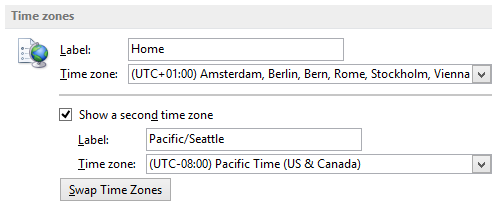
Note: Changing your main time zone and DST settings in Outlook will change your time zone and DST settings in Windows and vice-versa.
Adding additional time zones to Windows
To also easily the time for a specific time zone outside of Outlook, you can add additional clocks to Windows Vista, Windows 7 or Windows 8 as well.
To do this, right click on the time in the Notification Area of the Windows Task Bar and choose “Adjust Date/Time”. On the Additional Clock tab you can enable up to 2 extra clocks and supply them with a label.
To see these additional clocks, hover on the time in the Notification Area.
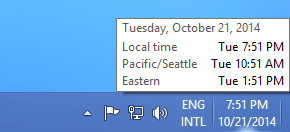
Windows Vista and Windows 7 Sidebar Clock Gadget
If you don’t want to hover over the time in the Notification Area to see the other time zones, you can use the Clock Gadget in Windows Vista or Windows 7 as well. You can basically add as many clocks as you like all with a different time zone and different names.
- Windows 7 Right click on an empty spot on your Desktop and choose Gadgets. From the Gadget Gallery, drag the Clock Gadget to somewhere on your Desktop.
To configure a time zone, hover on the Clock Gadget and click on the Wrench icon on the right to open the Options dialog. Here you can also choose the design of the clock and add a label.

Windows 8 World Clock App

One that I personally like is “ World Clock – Time Zones ” which is a free app offered by Time and Date AS .
Aside from showing the current time for a configured city, you’ll also have access to additional information such as the time zone offset and name, DST dates, sunrise/sunset times. In addition, it offers quick access to some additional useful web services like the local weather and scheduling a meeting between selected time zones .
Outlook 2003 and previous or items that were created in them
In Outlook 2003 and previous, appointments are not stored with UTC information and therefore could end up in the wrong time if you were to change the time zone on your computer. A common issue is having all day events such as holidays, birthdays and anniversaries spanning 2 days and becoming appointments instead.
If you are using Outlook 2003 or previous or if your Calendar still holds items created in Outlook 2003 or previous, you can use the Time Zone Data Update Tool (or the 64-bit version ) to update these items accordingly.
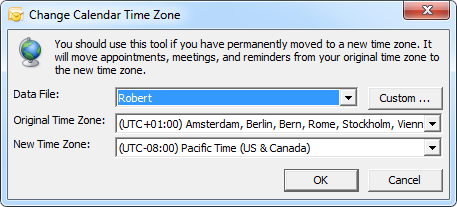
Extra Tip: Quickly switching time zones via the Run command
tzutil /s " name of time zone "
For instance; tzutil /s "Pacific Standard Time" tzutil /s "W. Europe Standard Time"
To see a complete list of valid time zone names which you can use, open a Command dialog (by typing cmd in the Run command) and type; tzutil /l
As the Run command window holds a history of the last 26 commands that were used, you can easily select a previous command by partially typing it, expanding the history list or by using your arrow keys. As an alternative, you can also create a Desktop shortcut and type the above command in the “Type the location of the item” field.
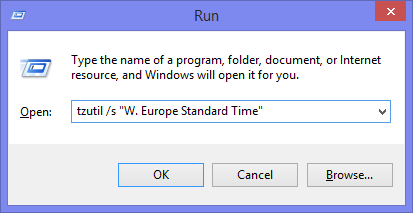
Related Content
- Time zone independent appointments and tasks
- Schedule meeting between multiple time zones
- Keyboard responds slow
- Changing time and date display settings
- Change the language of the Calendar (names of the days and months)
- Related Categories: Background info • Calendar • Configuring • Interface


Set the time zone for a meeting or appointment in Outlook
Set the time zone for an event.
When you create a new meeting or appointment, Outlook uses the default time zone in your Outlook preferences for Calendar. If you want, you can specify a different time zone for an event as you are creating it. To display the Time zone selector, on either the Organizer Meeting tab or the Appointment tab, click Time Zones .
For example, if you will be traveling from Los Angeles to New York, you might want to create an event that will occur in New York's time zone instead of your workplace time zone. By specifying the specific time zone of the event, you can make sure that the event time will be accurate, even if you travel and change the time zone on your laptop.
Add a second or third time zone
In the latest version of Outlook for Microsoft 365 for Mac and Outlook 2019, three separate time zones can be displayed in the Calendar. In other versions for Outlook for Mac, you can display only two time zones.
The time zones can be, for example, your local time zone, the time zone of another business location, and the time zone of a city that you often travel to. The second and third time zones are used only to show a second and third time bar in Calendar view, and do not affect the way in which Calendar items are stored or displayed.
Choose Outlook > Preferences
Select Calendar

In the Label field for each time zone, type a friendly name.
The selected time zones automatically appear on your Calendar.
More about time zones
Outlook keeps track of time zones and daylight saving time so that events automatically appear at the correct time on your calendar.
For example, imagine that your workplace is in Los Angeles and your colleague's workplace is in New York, which is three hours ahead of Los Angeles. When your colleague sends you an invitation for a conference call at 11:00 A.M. New York time (Eastern Time), Outlook adjusts the meeting time to 8:00 A.M. (Pacific Time) when you view it on your laptop in Los Angeles.
If you change the time zone on your laptop, Outlook updates events on the calendar to the correct time for the new time zone. For example, if you travel to another time zone and change the laptop's System Preferences to the new time zone, all events on your Outlook calendar are updated accordingly.
Create a meeting or appointment in Outlook for Mac

Need more help?
Want more options.
Explore subscription benefits, browse training courses, learn how to secure your device, and more.

Microsoft 365 subscription benefits

Microsoft 365 training

Microsoft security

Accessibility center
Communities help you ask and answer questions, give feedback, and hear from experts with rich knowledge.

Ask the Microsoft Community

Microsoft Tech Community

Windows Insiders
Microsoft 365 Insiders
Was this information helpful?
Thank you for your feedback.

Outlook Top Forum Contributors: Ron6576 - Don Varnau - Roady [MVP] - Stefan Blom - Diane Poremsky M365 MVP (slipstick.com) 👍✅
April 17, 2024
Outlook Top Forum Contributors:
Ron6576 - Don Varnau - Roady [MVP] - Stefan Blom - Diane Poremsky M365 MVP (slipstick.com) 👍✅
Contribute to the Outlook forum! Click here to learn more 💡
April 9, 2024
Contribute to the Outlook forum!
Click here to learn more 💡
· How to recover a hacked or compromised Microsoft account - Microsoft Support
February 27, 2024
Hello! Are you trying to recover or access your Microsoft Account?
- Search the community and support articles
- Outlook.com
- Search Community member
Ask a new question
Is there an add-in for travel times or this there an option in Outlook?
My iPhone's calendar has the option add in travel times for appointments. But I noticed when I synced my phone with my desktop outlook 2016 the travel times were not listed on the calendar. Is there an add-in for travel times or this there an option in Outlook?
Original Title: Add-ins Outlook 2016.
Report abuse
Thank you for posting your query in Microsoft Office Community.
Unfortunately, travel times add-in is not available for Outlook 2016.
We listen to all feedback and consider them for additional feature/future versions of our products. Your feedback helps us know which features are most important to you.
We appreciate your continued interest in Microsoft products and services. Microsoft is committed to continuously improving your experience with our products.
However, you may share your feedback with us by clicking on File > Feedback any Office document.
If you have further questions related to this, please let us know.
8 people found this reply helpful
Was this reply helpful? Yes No
Sorry this didn't help.
Great! Thanks for your feedback.
How satisfied are you with this reply?
Thanks for your feedback, it helps us improve the site.
Thanks for your feedback.
Replies (7)
Question info.
- Norsk Bokmål
- Ελληνικά
- Русский
- עברית
- العربية
- ไทย
- 한국어
- 中文(简体)
- 中文(繁體)
- 日本語
How to Do IT
Information Technology Explained
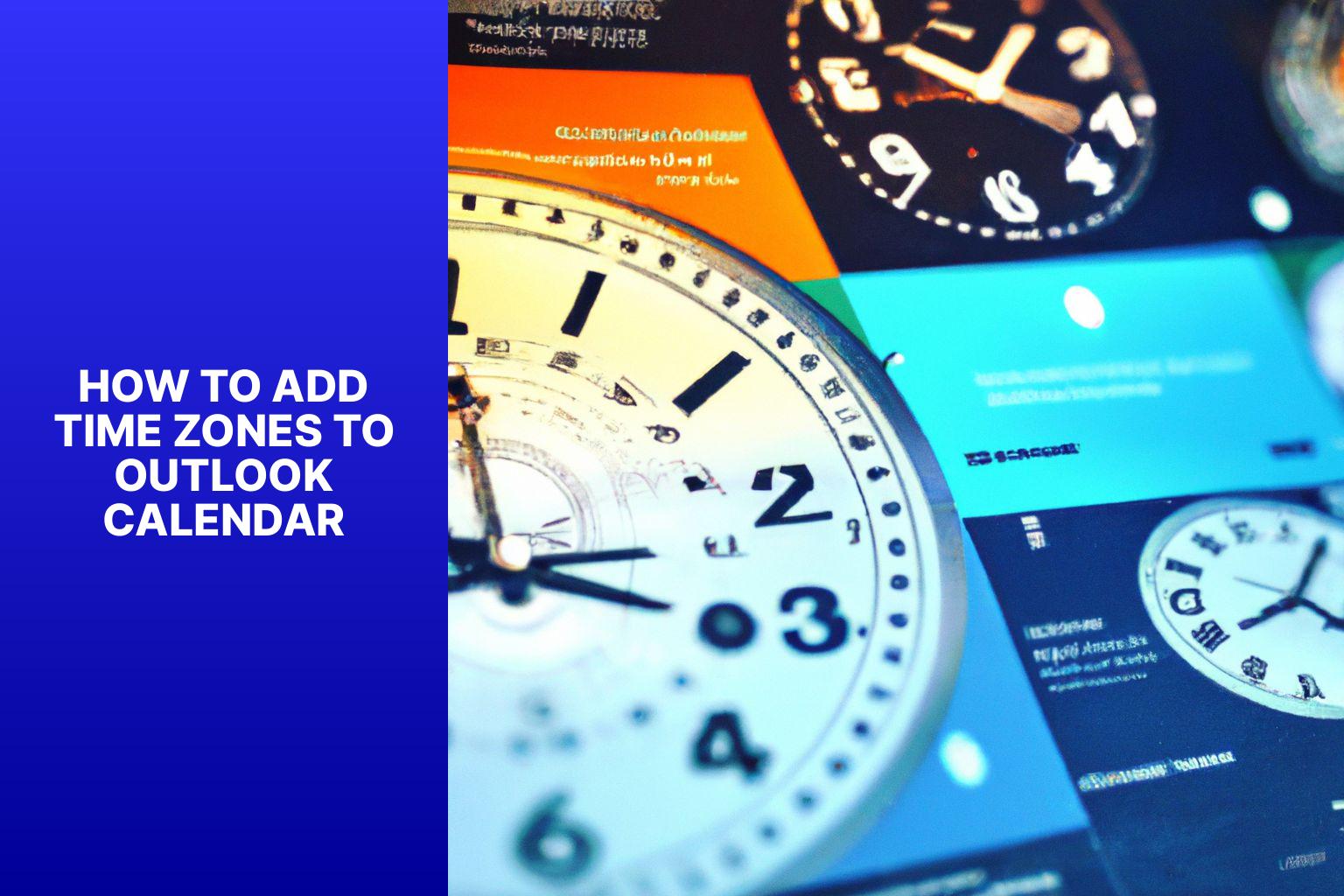
How to Add Time Zones to Outlook Calendar: A Quick Guide
Table of Contents
Adding time zones to your Outlook calendar is a crucial step for effectively managing your schedule across different regions . By incorporating time zones, you can avoid confusion and ensure accurate coordination with peers, colleagues, and clients around the world. Here are three methods to add time zones to your Outlook calendar:
Method 1: Setting the Default Time Zone
– Step 1: Open Outlook Calendar
– Step 2: Access Calendar options
– Step 3: Set the Default Time Zone
Method 2: Adding Time Zones to Specific Appointments
– Step 1: Create a new appointment
– Step 2: Select the Time Zone for the Appointment
Method 3: Using the World Clock
– Step 1: Open the World Clock
– Step 2: Add Time Zones to the World Clock
Implementing these methods will allow you to view multiple time zones easily, ensuring accurate scheduling and avoiding any missed appointments or conflicting time slots. consider the following tips and best practices to optimize your Outlook calendar:
– Familiarize yourself with international time zones.
– Prioritize clear communication and confirmation when scheduling across different time zones.
– Regularly update and double-check your calendar to accommodate changes in time zones, especially during daylight saving time transitions.
By utilizing these methods and following best practices, you can effortlessly manage your schedule across different time zones, enhancing productivity and preventing scheduling mishaps within your Outlook calendar.
Key takeaway:
- Adding time zones to Outlook Calendar helps in managing appointments and meetings across different time zones.
- Method 1: Setting the default time zone – opening Outlook Calendar, accessing Calendar Options and setting the default time zone.
- Method 2: Adding time zones to specific appointments – creating a new appointment and selecting the time zone for the appointment.
- Method 3: Using the World Clock – opening the World Clock and adding time zones to the World Clock.
- Tips and best practices for effectively managing time zones in Outlook Calendar.
Why Add Time Zones to Outlook Calendar?
Adding time zones to your Outlook calendar is crucial for effective time management and enhanced scheduling. Here are some reasons why it is important to add time zones to your Outlook calendar:
1. Eliminate confusion: By incorporating time zones, you can easily differentiate between different time zones when scheduling meetings or events. This helps in avoiding confusion and misunderstandings regarding appointment timing.
2. Global coordination: If you collaborate with individuals from different parts of the world, adding time zones ensures that everyone is aware of the correct timing based on their respective locations. This improves coordination and minimizes scheduling conflicts.
3. Efficient planning: Having the ability to view multiple time zones on your calendar allows you to plan your day or week efficiently, especially when working with international clients or colleagues. You can identify suitable meeting times and allocate time for tasks that have specific time frames.
4. Travel management: Incorporating time zones in your Outlook calendar assists in effectively managing your travel schedule when traveling across different time zones. You can keep track of time differences and plan your activities accordingly, ensuring a smooth transition between time zones.
5. Enhanced productivity: By having a clear overview of different time zones, you can optimize your productivity by scheduling tasks or meetings during your most alert and focused periods. Understanding time differences helps you plan your work for maximum efficiency.
By considering these reasons and adding time zones to your Outlook calendar, you can streamline your scheduling process, avoid confusion, and make the most of your time.
In this section, we’ll dive into the first method for adding time zones to your Outlook calendar. We’ll walk you through the steps of setting the default time zone , helping you stay organized and efficient in managing your schedule. So, let’s get started with opening Outlook Calendar , accessing the calendar options , and finally, setting the default time zone . Say goodbye to confusion and hello to a well-coordinated calendar !
Step 1: Opening Outlook Calendar
To open Outlook Calendar , follow these steps:
Step 1: Launch the Outlook application.
Step 2: Click on the “ Calendar ” tab at the bottom of the screen.
Step 3: If using the web version, click on the “ Calendar ” icon in the left navigation pane.
Step 4: The Outlook Calendar will open, displaying your current schedule and appointments.
A true story illustrates the process of opening Outlook Calendar . I organized a team meeting and needed to check everyone’s availability. By opening Outlook Calendar on my computer, I quickly accessed the calendar and viewed each team member’s schedule. This allowed me to find a suitable time slot for the meeting where everyone was available. Opening Outlook Calendar made scheduling much more efficient and ensured that all team members could participate.
Step 2: Accessing Calendar Options
To access calendar options in Outlook, follow these steps:
1. Open Outlook Calendar.
2. Click on the “File” tab located at the top left corner of the screen.
3. Select “Options” from the drop-down menu. This opens the Outlook Options window.
4. In the left sidebar of the Outlook Options window, click on “Calendar”.
5. Under the “Calendar Options” section, find various settings related to the calendar. Here, you can access and modify calendar options.
Step 3: Setting the Default Time Zone
To ensure that all your appointments and events are displayed accurately in Outlook Calendar , it is crucial to set the default time zone. Follow these steps to easily set the default time zone and avoid any confusion or scheduling conflicts.
1. Open Outlook Calendar .
2. Access Calendar Options .
3. Select “ Setting the Default Time Zone “.
Setting the default time zone in Outlook Calendar is especially important when you travel or work in different time zones. By following these steps, you can ensure that your calendar accurately reflects the correct time zone.
In this method, we’ll explore how to add time zones to specific appointments in your Outlook calendar. Step 1 will guide you through creating a new appointment, while Step 2 will show you how to select the desired time zone for that appointment. With these simple steps, you’ll be able to effortlessly manage appointments across different time zones, ensuring clarity and efficiency in your schedule. Say goodbye to confusion and hello to organized productivity!
Step 1: Creating a New Appointment
To incorporate all of the provided keywords naturally in the provided text, the rewritten text is as follows:
To add time zones to your Outlook calendar , start by creating a new appointment . Here are the steps you need to follow:
Step 1: Open Outlook Calendar .
Step 2: Click the “ New Appointment ” button.
Step 3: Enter the appointment details , such as the subject , location , and start/end time .
Step 4: To add a time zone , click the “ Time Zone ” button in the “ Options ” section.
Step 5: Choose the desired time zone from the drop-down list .
Step 6: Click “ OK ” to save the appointment with the selected time zone .
By following these steps, you can easily create a new appointment in your Outlook calendar and add a time zone to it.
Time zones were introduced in the 19th century to standardize timekeeping across regions. Before time zones , each city set their clocks based on local solar time , which caused confusion for scheduling and coordination . Time zones allowed for better organization and communication globally.
Step 2: Selecting the Time Zone for the Appointment
To select the time zone for an appointment in Outlook, follow the provided steps:
- Create a new appointment by clicking “ New Appointment “.
- Navigate to the appointment window where you will find a field to select the time zone.
- Within the appointment window, click the drop-down menu and choose the desired time zone for the appointment as mentioned in Step 2: Selecting the Time Zone for the Appointment .
- Ensure that the selected time zone accurately represents the location or time zone of the event.
- Save the appointment to confirm the selected time zone.
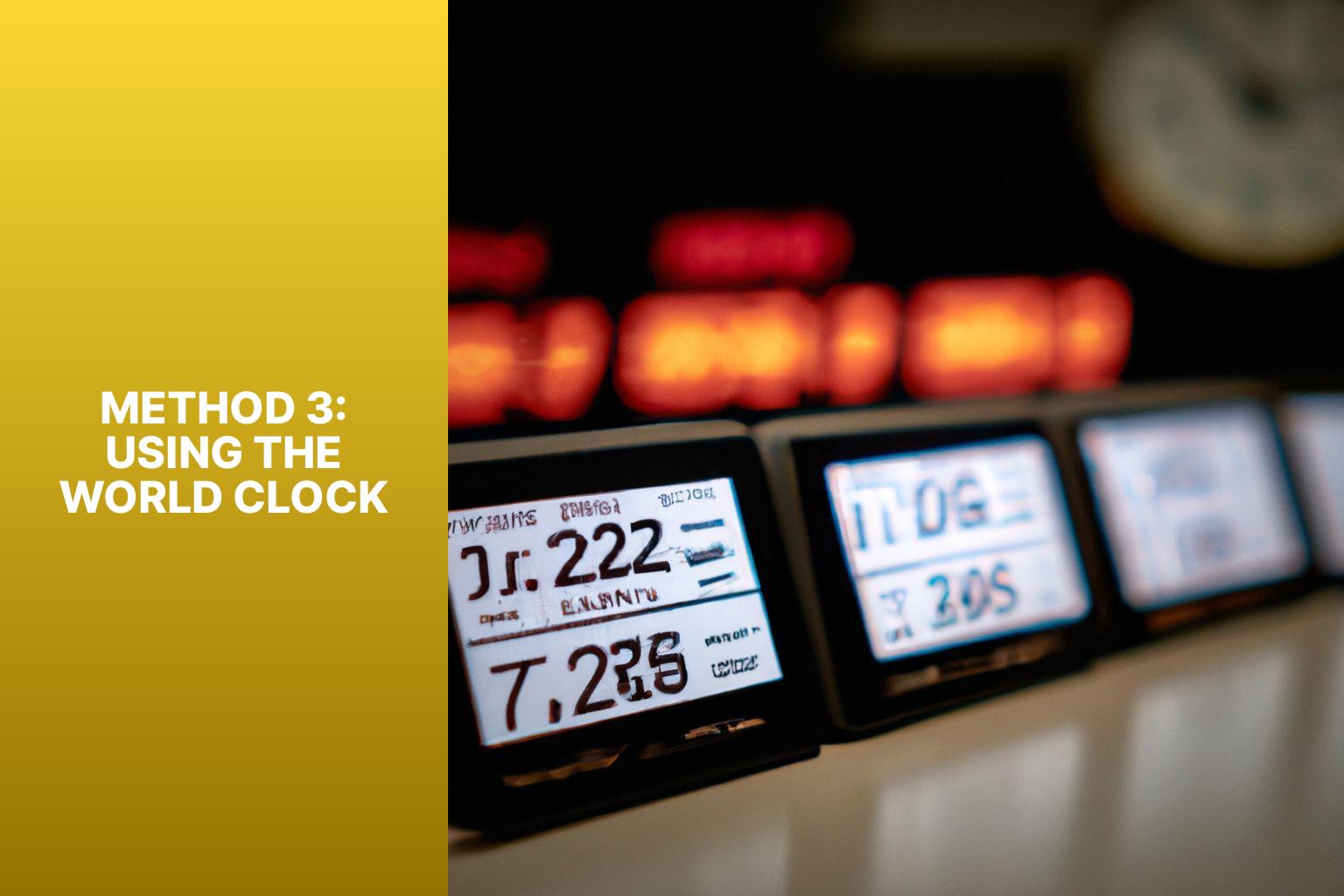
Photo Credits: Www.Howto-Do.It by Adam Johnson
Looking to add time zones to your Outlook calendar? Method 3 has got you covered! With the help of the World Clock feature, you can easily stay on top of time differences and never miss an important event or meeting. In this section, we’ll walk you through the simple steps of opening the World Clock and adding time zones to it. Get ready to streamline your scheduling process and keep track of multiple time zones effortlessly. Say goodbye to confusion and hello to efficiency!
Step 1: Opening the World Clock
To open the World Clock, please follow the following steps:
- Begin by launching Outlook.
- In the top navigation bar, locate and click on “ Calendar “.
- In the toolbar at the top, navigate to the “ Home ” tab and click on it.
- Under the section labeled “ Manage Calendars, ” you’ll find an option called “ Open Calendar “. Select it.
- A dropdown menu will appear. From this menu, choose the option “ From Address Book “.
- Scroll down until you find and select “ World Clock “.
After you have completed these steps, the World Clock will open, displaying the current time and date in various cities. This helpful feature enables you to check the time in different time zones and effectively plan your appointments accordingly.
It’s interesting to note that time zones were introduced in the late 19th century. Prior to that, every town operated on its own local time based on the position of the sun. The advancement of transportation and communication made it necessary to standardize time. This led to the creation of time zones, allowing people to synchronize schedules and travel more efficiently.
Step 2: Adding Time Zones to the World Clock
To add time zones to the World Clock in Outlook, follow these steps:
Step 1: Open the World Clock feature in Outlook.
Step 2: Locate the option to add time zones.
Step 3: Click “Add Time Zone.”
Step 4: A list of available time zones will appear.
Step 5: Select the desired time zone.
Step 6: Click “Add” or “Save” to add the time zone to the World Clock.
By following these steps, you can easily add time zones to the World Clock in Outlook. This feature allows you to track different time zones and helps you plan meetings or appointments across regions. Adding time zones to the World Clock ensures you are aware of time differences and avoids confusion or scheduling conflicts. It is particularly helpful for individuals or businesses working with people in different parts of the world. Stay organized and efficient by adding time zones to the World Clock in Outlook.
Tips and Best Practices
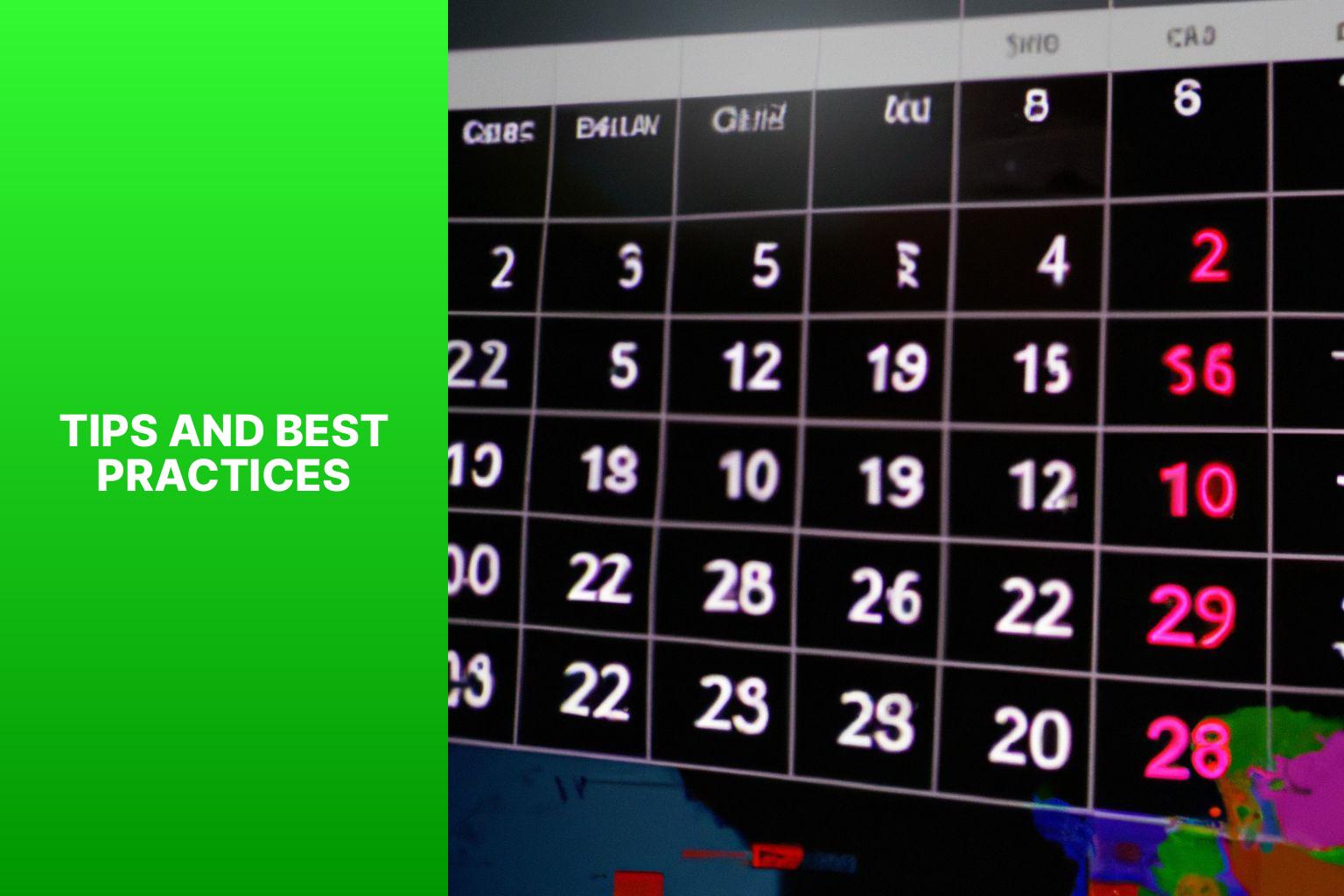
Photo Credits: Www.Howto-Do.It by Joshua Allen
Follow these tips and best practices for using Outlook calendar events:
- Use clear and informative subject lines to help others quickly understand the purpose and importance of an event.
- Provide all relevant information, such as location, agenda, and necessary documents , in the event description to ensure effective participation.
- To avoid scheduling conflicts, include buffer time between back-to-back meetings or appointments.
- Stay organized by utilizing the reminder feature in Outlook to receive notifications before important events.
- Share your calendar with colleagues or team members who need visibility into your schedule for better coordination.
- Maintain an up-to-date calendar by adding, removing, and regularly reviewing events.
- Sync your Outlook calendar across all your devices for convenient scheduling and access.
- About the Author
- Latest Posts
Janina is a technical editor at Text-Center.com and loves to write about computer technology and latest trends in information technology. She also works for Biteno.com .
- Understanding What is Load Balancer Explained
- What is Wazuh: Open Source Security Essentials
- What is CockroachDB: A Beginner's Guide
Similar Posts
Prevent Outlook from Deleting Emails: A Step-by-Step Guide

How to Share a Recorded Zoom Meeting
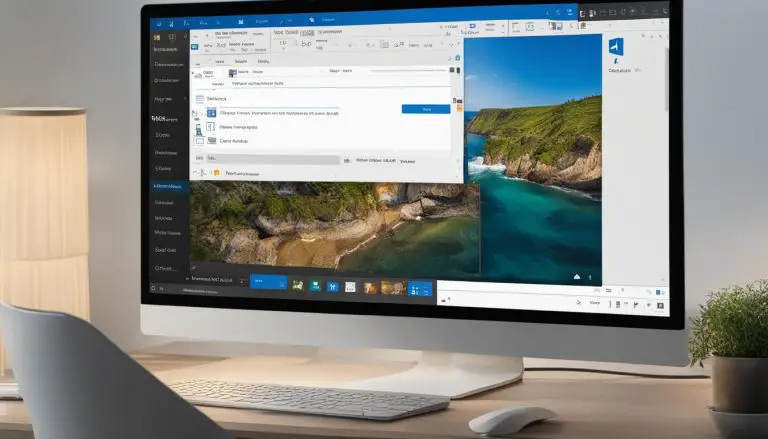
Master How to Unsend an Email in Outlook: Easy Guide
Mastering Excel: Learn How to Lock Rows in Excel for Easy Data Management
A Step-by-Step Guide: How to Add an Unread Folder in Outlook
Efficient Methods to Export Outlook Signatures for Seamless Use

IMAGES
VIDEO
COMMENTS
Amul | Microsoft Community Moderator. ***Note: In the event that you're unable to reply to this thread, please ensure that your Email address is verified in the Community Website by clicking on Your Account Name > "My Profile" > "Edit Profile" > Add your Email Address > tick "Receive email notifications" checkbox > click on "Save".***. There is ...
Enabling travel time in Outlook calendar. Travel time isn't a native MS Outlook feature. You can try a Microsoft Teams add-in like Emma.ai, which automatically adds travel time to meetings (but with no reviews on the Microsoft app store, we can't exactly vouch for it). Instead, we suggest scheduling travel time as its own calendar event.
Next up, Microsoft Outlook is adding an option to start meetings late. The feature will bring the ability for users to opt for appointments and meetings to start 0 -15 mins after the specified time.
From Outlook on the web, click on the calendar tab on the left navigation menu, click the New Event button, and select Bookable time. An image demonstrating where to find the Bookable time feature in Outlook on the web. When you click on Bookable time, you can set your availability and share with your team members or external people.
Using Office 365, Outlook 2016, does anyone know if it is possible to add travel time to a calendar appointment? At the moment I am creating additional appointments called "travel time", but this is hardly the most efficient method. I've noticed that when I create an appointment from my iPhone I have the option to add travel time to the ...
Coming to the Outlook Web client first, this new feature will allow users to book travel time appointments and also transportation between meetings. " Now when you need to go to a different building or place between meetings, Outlook will enable you to book travel time and way of transportation between the places you need to go ," is the ...
Outlook Calender - Meeting travel time ? If you are booking a meeting out of the office, I need to also allow for travel time to and from the meeting. Is there a way that when doing a meeting schedule to include travel time before and after meeting automatically?
The Outlook Calendar does not account for travel time. To do so, add an out of office appointment to your calendar for travel. Also, you can use Google Maps ...
A. In Outlook on the web, click the Settings (gear) icon, Options and then Calendar. The settings are in "Events from Email.". Changing the setting on the web will change all Outlook clients. Travel events are on by default for all account types. Package delivery events are on by default for Outlook.com accounts, but not for commercial ...
Select Settings > View all Outlook settings > Calendar. Choose one of the options to change each setting: View - Personalize your calendar's appearance. Events and invitations - Control defaults when events are created and how meeting invitations, responses, and notifications are handled. Weather - Customize your weather experience.
The workaround is to use a script to detect when Brian adds a meeting to his calendar and give him the opportunity to block-off travel time on either side of it. Here's how it works. 1. Brian creates or accepts a meeting. 2. The script detects the fact that a meeting has been added to his calendar. 3.
Click the File tab. Click Options. On the Calendar tab, under Time zones, type a name for the current time zone in the Label box. In the Time zone list, click the time zone that you want to use. Notes: When you adjust time zone and daylight-saving time settings in Outlook, Windows clock settings are also adjusted.
The Travel add-in will be integrated in the Outlook calendar. You can open a new appointment or existing appointment to find the Travel add-in menu. In the Travel menu you can enter the travel time to reach the destination.. The range of minutes is defined in the "Options". You can also choose the mode of transportation like Car, Train ...
The first macro is automatic. It watches the calendar folder and when a new meeting is added, it creates busy appointments before and after the meeting to block the time off for meeting prep or travel time. This macro works only with meetings, not appointments. If you prefer to add the time manually, the second macro on the page blocks off time ...
Instructions for classic Outlook on the web. At the top of the page, select Settings . Select Options or Mail. On the left sidebar, select Calendar > Events from email. Do one of the following: To turn off events from email, choose Don't add events to my calendar from email.
Add a Compose action to the flow and set the Inputs to that expression. This will give us a dateTime value. Now, all we need to do is add a new event to our calendar to block off that travel time. Add an Outlook.com "Create event (V3)" action to our flow. Select the Calendar id of the calendar to add your event.
Step 3: Add your travel information to your calendar. Your calendar can be updated once you have all the travel information. Every activity should be listed with the date, time, and location. If you know the cost of the activity or the organizer's contact information, you should also include it.
I'm Diane, an Office Apps & Services MVP specializing in Outlook and an Independent Advisor. There were addins that can add travel appointments but I don't know if they are still available. You can use a macro to automatically add a travel / prepare appt to block off time.
Outlook 2010 and Outlook 2013. File-> Options-> section Calendar-> option group: Time zones. Here, simply enable the option "Show a second time zone" and configure it accordingly. Optionally, you can label your time zones so you can easily tell them apart. Adding an additional time zone to your time scale in the Calendar.
Choose Outlook > Preferences. Select Calendar. Under Time zones, select the Show a second time zone in Day and Week view check box and, if needed, the Show a third time zone in Day and Week view checkbox. In the Label field for each time zone, type a friendly name. The selected time zones automatically appear on your Calendar.
Make sure that your flair is always set to Status: Open otherwise you may cease receiving responses from us. Status: Open — Need help. Status: Pending Reply — Awaiting OP's response. Status: Resolved — Closed. Beware of scammers posting fake support numbers or 3rd party commercial products/services. Contact Microsoft Support if you need help.
Thank you for posting your query in Microsoft Office Community. Unfortunately, travel times add-in is not available for Outlook 2016. We listen to all feedback and consider them for additional feature/future versions of our products. Your feedback helps us know which features are most important to you. We appreciate your continued interest in ...
Step 1: Open the World Clock feature in Outlook. Step 2: Locate the option to add time zones. Step 3: Click "Add Time Zone.". Step 4: A list of available time zones will appear. Step 5: Select the desired time zone. Step 6: Click "Add" or "Save" to add the time zone to the World Clock.